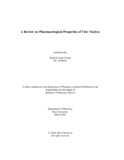A review on pharmacological properties of vitis vinifera

View/Open
Date
2022-03Publisher
Brac UniversityAuthor
Tushar, Mahbub AlamMetadata
Show full item recordAbstract
Among different fruit plants, the grape plant is widely regarded as one of the essential sources of phenolic compounds, including resveratrol, phenolic acids, kaempferol, quercetin, catechins, proanthocyanins, etc. Several studies have demonstrated that those polyphenols or nutraceuticals obtained from the plant grapes have health benefits, including lowering the incidence of cardiovascular disease or cancer, improving cognition and neuronal function with aging and neurodegenerative diseases, and exhibiting antiallergic, antitumor, anti-inflammatory, antidiabetic, and antimicrobic properties. These polyphenols can also help us live longer lives by improving our health conditions, delaying the aging process, preventing chronic diseases, increasing our life expectancy, or supporting the structure and function of our bodies. The wine, grape seeds, and grape skins contain a significant amount of those phenolic compounds. Wine is regarded as a particularly excellent source of grape phenolic compounds. Research on polyphenols and pharmacological properties of Vitis vinifera have been summarized in this article.
